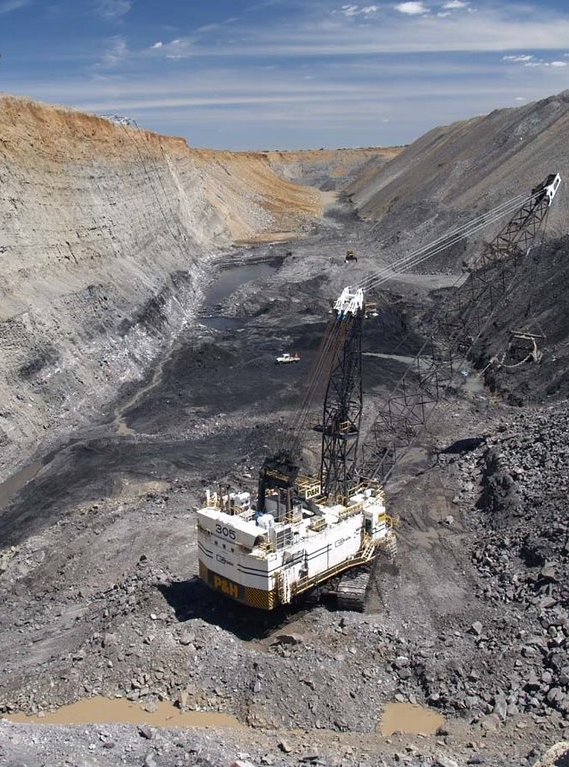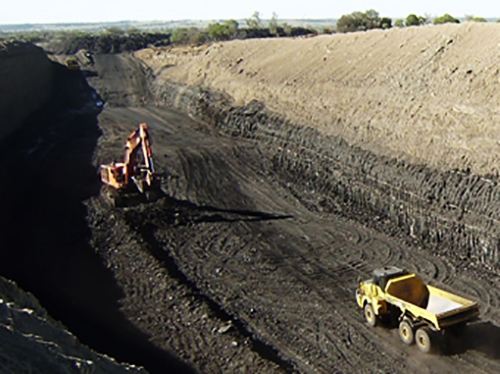This case involved an objection against the Wandoan Coal Mine, a major open-cut coal mine proposed to operate for 35 years in the Surat Basin of Queensland. It is commonly known as the “Xstrata Case”.
The mine was part of the Wandoan Coal Project proposed in 2007 by Xstrata Coal Queensland Pty Ltd and its joint venturers (taken over by Swiss mining gaint Glencore in 2013). It was proposed to be located west of the township of Wandoan, approximately 350 km northwest of Brisbane and 60 km south of Taroom.
The thermal coal deposits for the mine were estimated to be in excess of 1.2 billion tonnes and are located within three mining lease applications covering approximately 32,000 hectares.
Consultants for the applicants prepared an environmental impact statement that calculated that the mining and use of the coal would produce 1.3 billion tonnes of greenhouse gases.
In Queensland, the major approvals required for large mines under State and Federal legislation are:
- a mining lease under the Mineral Resources Act 1989 (Qld) (MRA);
- an environmental authority under the Environmental Protection Act 1994 (Qld) (EPA); and
- approval under the Environment Protection and Biodiversity Conservation Act 1999 (Cth) (EPBC Act).
The Queensland Coordinator-General declared the mine and rail project a “significant project” in 2007 (this designation later changed to being a “coordinated project”) under the State Development and Public Works Organisation Act 1971 (Qld). This legislation provides an environmental impact statement (EIS) process for large projects but does not actually approve the projects occurring. An EIS under it is fed-back into other approval processes.
An EIS was prepared for the mine and rail project in 2007-2010 and the Coordinator-General issued a report in 2010 recommending the mine be approved.
Concurrently with the Queensland assessment of the mine, it was assessed under the EPBC Act using a bilateral agreement and subsequently approved by the Commonwealth Environment Minister in 2011.
Following the Coordinator-General’s report, the mine was publicly advertised for objections under the MRA and EPA.
The Friends of the Earth – Brisbane Co-Op Ltd (FoE), a conservation group, lodged an objection to the mine due to the contribution its emissions will make to climate change and ocean acidification.
Neighbouring landholders also objected to the mine due to noise, dust, groundwater and other issues; however, these objections are not the focus here.
The objection by FoE and other objections by neighbouring farmers was heard by the Land Court of Queensland in Brisbane, from 22 August – 31 August 2011.
In 2012 the Land Court (constituted by President MacDonald) dismissed FoE’s objection and recommended that the mining lease and environmental authority be granted. Some changes were recommended to address concerns raised by the landholders. This decision is commonly known as the “Xstrata Case”.
FoE appealed the decision to the Land Appeal Court but discontinued the appeal before a decision was reached.
The environmental authority for the mine was issued in August 2012, however, the process for the mining lease was put on hold in 2012 due to poor market conditions for coal. It was eventually issued on 8 August 2017.
The mine has been subject to separate litigation in the Land Court over compensation of landholders.
Postscript: mine delayed
In November 2012 the future of the mine was reported to be in doubt due to market conditions. The price of thermal coal decreased substantially and the market outlook was poor due to a range of factors, including global responses to climate change.
In March 2013 the mine was reported to be even less likely to proceed due to the risk of the project and market conditions.
In September 2013 the mine was reported to have been placed on indefinite hold due to market conditions and the business risks involved in proceeding.
In mid-2017 “new life” was reported to have been breathed into the project.
In early 2019 the mine was still on hold but Glencore stated it was still considering the project when announcing an overall cap on its GHG emissions from coal mining.
In early 2023, Glencore was reported to have said:
[It] “planned to use about 4 million tonnes a year from the resource for the potential production of blue hydrogen with carbon capture and storage.
We do not plan to develop the Wandoan coal resource as a traditional coal mine for the purpose of servicing the traditional coal markets.
We are investigating the potential to produce blue hydrogen and ammonia through utilising a relatively small portion of the Wandoan coal resource as feedstock.
… the project was at an early stage and no investment decision had been made. About 90 per cent of the emissions would be captured and stored.
We believe this blue hydrogen project with CCS could be an important bridge to enabling the broader uptake of hydrogen technology and applications in Australia and globally.
Subject to final approvals and final investment decision, a commercial scale blue hydrogen project with CCS located in Wandoan could provide a range of socio-economic opportunities for the surrounding region. We welcome further engagement with all stakeholders on this project.”
[It] “expected that blue hydrogen could be produced economically while green hydrogen, which uses water and has no emissions, required a ‘step-change’ in costs.”
Climate change reasoning rejected a decade later
The Land Court’s reasoning on climate change in the Xstrata Case (in 2012) – the “Drug Dealers Defence” that, if we don’t mine the coal someone else will; therefore, there is no impact on climate change – was adopted by the Land Court in the later cases involving:
- the Alpha Coal Mine (2013) (in which the Drug Dealers Defence was affirmed by the Queensland Supreme Court (in 2015) and Court of Appeal (in 2016));
- Adani’s Carmichael Coal Mine (2015);
- Kevin’s Corner Mine (2017); and
- the New Acland Mine (2017).
Each of these Queensland cases are a separate case study on this site.
The Drug Dealers Defence has been rejected in New South Wales in 2019 by Preston CJ in his seminal decision in Gloucester Resources rejected the Drug Dealers Defence (or “market substitution” argument) as “flawed”.
The reasoning in the Xstrata Case was followed for a decade in Queensland until a new President of the Land Court, President Kingham, rejected the Drug Dealers Defence in Waratah Coal v Youth Verdict [2022] QLC 22. Her Honour summarised her rejection of this argument in the Executive Summary:
“[31] Waratah says approving the mine will make no difference to total emissions, because it will displace other lower quality coal with higher GHG emissions. I reject that submission, as well as its submissions that there will be a beneficial climate outcome if the Project is approved and an adverse climate outcome if it is not. Although the Project coal might displace other supply in its market, that is most likely to be other high rank coal, with similar GHG emissions.”
The rejection of the Drug Dealers Defence in Waratah Coal v Youth Verdict [2022] QLC 22 was a legal first for Queensland and a very substantial departure from previous decisions of the Land Court in similar cases.
Key documents
Mining application & EIS documents
- Application for a mining lease and an environmental authority.
- Location map of the mine.
- Mine layout plan and 30-year mining schedule. The proposed mine has 14 pits, several 5km x 5km in area, and is approximately 30km east to west and 20km north to south. The pits will go to around 70m in depth.
- Initial Advice Statement by Xstrata seeking declaration that mine is a significant project.
- Declaration that the mine was a significant project by the Coordinator-General.
- Terms of reference for EIS.
- Environmental Impact Statement (EIS), including calculation of the greenhouse gases to be produced by the mine in Chapter 14 of Volume 1 and an attached technical report available here.
- Supplementary EIS for the mine.
- Coordinator-General’s report (attaching a draft environmental authority (mining lease)).
- Timeline for approval of the mine 2007-2014.
Objection by FOE
- Objection lodged by FoE.
- Directions made by the Land Court setting out the steps leading up to the objections hearing on 22 August – 2 September 2011.
- Request for Further and Better Particulars by Xstratra.
- Response to Request for Further and Better Particulars by FoE.
Xstrata climate change expert reports
- Mr Jonathan Stanford report on policy & economics (Exhibit 77).
- Mr William Simes report on coal supply (Exhibit 75).
- Dr Chris Taylor report on GHG emissions (Exhibit 81).
- Cassandra McCarthy affidavit on research by the Xstrata Group into carbon capture and storage (Exhibit 47).
FOE climate change expert reports
- Professor Ian Lowe report on climate science [without attachments due to file size] (Exhibit 102).
- Dr Malte Meinshausen report on the contribution of the Wandoan Coal Mine to climate change and ocean acidification [without attachments to respect copyright] (Exhibit 103).
- Professor Ove Heogh-Guldberg report on impacts of climate change and ocean acidification on the Great Barrier Reef [without attachments to respect copyright] (Exhibit 104).
- Mr Hans Hoegh-Guldberg report on economic impacts of climate change on the Great Barrier Reef (Exhibit 105).
Xstrata supplementary climate change reports
- Jonathan Stanford supplementary report (Exhibit 78).
- William Simes supplementary report (Exhibit 76).
Submissions & trial decision
- Closing submissions by FoE.
- Decision recommending approval: Xstrata Coal Queensland Pty Ltd & Ors v Friends of the Earth – Brisbane Co-Op Ltd & Ors, and Department of Environment and Resource Management [2012] QLC 013
- Decision refusing application for costs by Xstrata against FoE: Xstrata Coal Queensland Pty Ltd & Ors v. Friends of the Earth – Brisbane Co-Op Ltd (No 2) [2012] QLC 67
Appeal to Land Appeal Court
- Notice of Appeal filed by FoE (later discontinued before a decision was reached, therefore, the appeal ended).
Approvals issued for mine
- Environmental authority issued in August 2012
- Mining leases issued on 8 August 2017 [not yet available]
-
An open-cut coal mine in Queensland (not the Wandoan Mine)
Source: Tony Nielsen
-
The proposed mine site
Source: Xstrata IAS
-
Sample pit near Wandoan showing one of the coal seams proposed to be mined
Source: Xstrata media image library
Media reports about this case
Xstrata admits Wandoan Coal may crumble in tough market, The Toowoomba Chronicle, 22 November 2012.
Xstrata chooses brown over green, Sydney Morning Herald, 7 March 2013.
Wandoan coal project scuppered, The Age, 11 September 2013.
Leases granted for Surat coal project, Minister for State Development & NRM, 8 August 2017.
Glencore’s Wandoan coalmine wins approval from Queensland government, The Guardian, 9 August 2017.
Queensland Government grants lease to Glencore’s $6 billion Wandoan coal project, Courier Mail, 9 August 2017.
Glencore secures leases for $7 billion Wandoan coal project, Australian Mining, 9 August 2017.
Glencore pressured to withdraw from new coalmines to prove climate change commitment, The Guardian, 21 February 2019.





